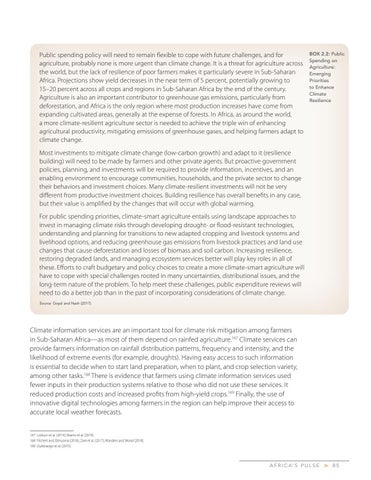Public spending policy will need to remain flexible to cope with future challenges, and for agriculture, probably none is more urgent than climate change. It is a threat for agriculture across the world, but the lack of resilience of poor farmers makes it particularly severe in Sub-Saharan Africa. Projections show yield decreases in the near term of 5 percent, potentially growing to 15–20 percent across all crops and regions in Sub-Saharan Africa by the end of the century. Agriculture is also an important contributor to greenhouse gas emissions, particularly from deforestation, and Africa is the only region where most production increases have come from expanding cultivated areas, generally at the expense of forests. In Africa, as around the world, a more climate-resilient agriculture sector is needed to achieve the triple win of enhancing agricultural productivity, mitigating emissions of greenhouse gases, and helping farmers adapt to climate change.
BOX 2.2: Public Spending on Agriculture: Emerging Priorities to Enhance Climate Resilience
Most investments to mitigate climate change (low-carbon growth) and adapt to it (resilience building) will need to be made by farmers and other private agents. But proactive government policies, planning, and investments will be required to provide information, incentives, and an enabling environment to encourage communities, households, and the private sector to change their behaviors and investment choices. Many climate-resilient investments will not be very different from productive investment choices. Building resilience has overall benefits in any case, but their value is amplified by the changes that will occur with global warming. For public spending priorities, climate-smart agriculture entails using landscape approaches to invest in managing climate risks through developing drought- or flood-resistant technologies, understanding and planning for transitions to new adapted cropping and livestock systems and livelihood options, and reducing greenhouse gas emissions from livestock practices and land use changes that cause deforestation and losses of biomass and soil carbon. Increasing resilience, restoring degraded lands, and managing ecosystem services better will play key roles in all of these. Efforts to craft budgetary and policy choices to create a more climate-smart agriculture will have to cope with special challenges rooted in many uncertainties, distributional issues, and the long-term nature of the problem. To help meet these challenges, public expenditure reviews will need to do a better job than in the past of incorporating considerations of climate change. Source: Goyal and Nash (2017).
Climate information services are an important tool for climate risk mitigation among farmers in Sub-Saharan Africa—as most of them depend on rainfed agriculture.167 Climate services can provide farmers information on rainfall distribution patterns, frequency and intensity, and the likelihood of extreme events (for example, droughts). Having easy access to such information is essential to decide when to start land preparation, when to plant, and crop selection variety, among other tasks.168 There is evidence that farmers using climate information services used fewer inputs in their production systems relative to those who did not use these services. It reduced production costs and increased profits from high-yield crops.169 Finally, the use of innovative digital technologies among farmers in the region can help improve their access to accurate local weather forecasts. 167 Lodoun et al. (2014); Boansi et al. (2019). 168 Fitchett and Ebhuoma (2018); Zare et al. (2017); Wanders and Wood (2018). 169 Ouédraogo et al. (2015).
A F R I C A’ S P U L S E
>
85

